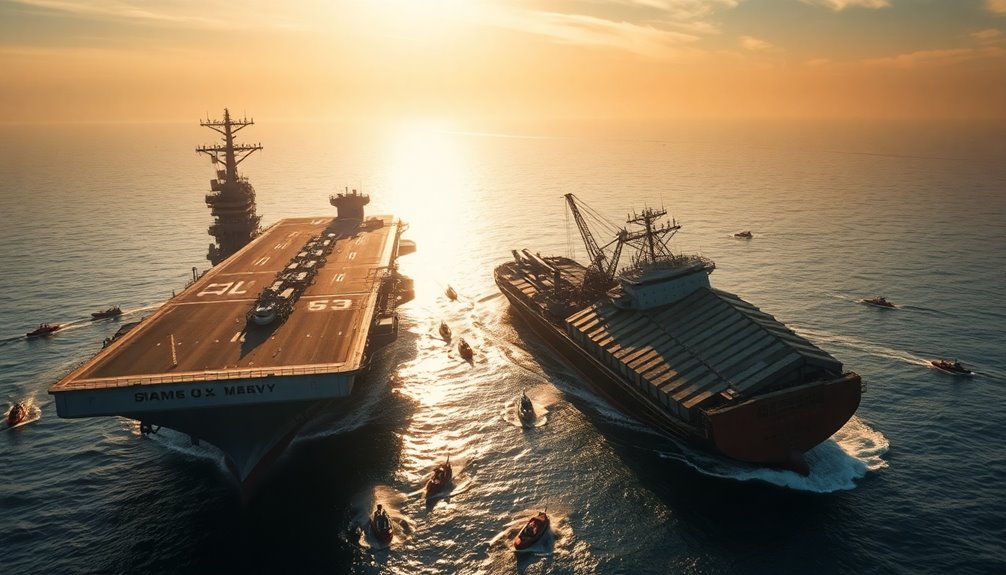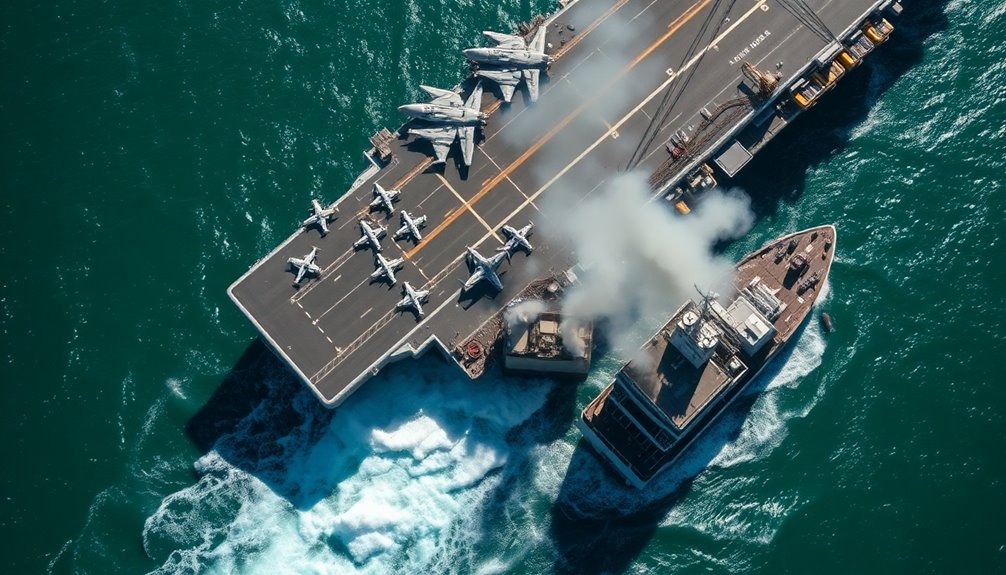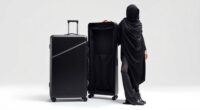On February 12, 2025, the USS Harry S. Truman, a US Navy aircraft carrier, collided with the Panamanian-flagged merchant vessel Besiktas-M near the Suez Canal. This incident highlights serious concerns about navigation safety in busy shipping lanes. Fortunately, there were no injuries or flooding reported on the carrier. Investigations are ongoing to determine the cause and implications for maritime operations. There's more to uncover about the incident and its broader impacts.
Key Takeaways
- The USS Harry S. Truman collided with the Panamanian merchant vessel Besiktas-M near Port Said, Egypt, on February 12, 2025.
- The incident occurred at 11:46 p.m. local time, raising concerns about navigation safety in busy waterways.
- No injuries or flooding were reported on the USS Harry S. Truman; its propulsion systems remained unaffected.
- The Besiktas-M was carrying nearly 30,000 tons of cargo and was en route to Constanta, Romania, with the vessel's condition unclear.
- The collision highlights risks to international trade routes, emphasizing the need for improved maritime safety protocols and navigation systems.

Late on February 12, 2025, the USS Harry S. Truman collided with the merchant vessel Besiktas-M near Port Said, Egypt, just a stone's throw from the Suez Canal. At approximately 11:46 p.m. local time, this incident unfolded, raising concerns about navigation safety in one of the world's busiest waterways.
You might wonder how such a collision could happen, especially involving a Nimitz-class aircraft carrier, known for its massive size and advanced technology.
The USS Harry S. Truman, which measures 1,092 feet long and 252 feet wide, is capable of carrying around 90 aircraft. Commissioned in 1998, it plays a crucial role in naval operations, specifically during its current mission, Operation Prosperity Guardian, aimed at defending commercial shipping from Houthi rebel threats.
Fortunately, there were no reported injuries or flooding aboard the Truman, and its propulsion systems remained unaffected after the collision. The USS Truman reported no flooding after the incident, which is a positive outcome given the circumstances.
On the other hand, the Besiktas-M, a bulk cargo carrier sailing under the Panamanian flag, was anchored near Port Said. This vessel, approximately 618 feet long and 105 feet wide, was en route to Constanta, Romania, carrying nearly 30,000 tons of cargo.
The status of the Besiktas-M and its crew following the incident remains unclear, leaving many questions unanswered about their condition.
The Suez Canal is a vital artery for global trade, with around 12% to 15% of the world's trade passing through it daily. The collision's timing is particularly concerning, given the heightened US Navy operations in the area to secure commercial routes.
An investigation is currently underway to determine the cause of this incident, and the implications could resonate through shipping lanes and naval operations for some time to come.
As you digest this news, it's essential to consider the broader impacts on maritime safety and international trade.
Frequently Asked Questions
What Are the Names of the Ships Involved in the Collision?
The ships involved in the collision are the USS Harry S. Truman and the Besiktas-M.
The USS Harry S. Truman is a Nimitz-class aircraft carrier, while the Besiktas-M is a Panama-flagged bulk carrier.
Both vessels play significant roles in maritime operations, with the Truman being a nuclear-powered carrier and the Besiktas-M carrying cargo.
This incident highlights the complexities of navigation in busy waterways, emphasizing the need for vigilance and communication at all times.
Were There Any Injuries Reported From the Incident?
No injuries were reported from the incident.
Both vessels' crews remained safe throughout, so there's no need to worry about casualties.
The USS Harry S. Truman didn't experience flooding, and its stability was unaffected, ensuring the safety of everyone onboard.
The bulk carrier, while sustaining some damage, also didn't report injuries to its crew.
It's crucial to note the effectiveness of safety protocols during such encounters in busy maritime areas.
How Often Do Collisions Like This Occur?
Consider the USS Fitzgerald collision in 2017; it highlights how naval and civilian ship collisions, while rare, can occur.
Historically, there've been around 184 documented cases from 1945 to 1988. Although collisions involving aircraft carriers are even less frequent, they still happen.
Human error, equipment failure, and poor communication often contribute.
What Is the Protocol After a Naval Collision?
After a naval collision, you should activate the vessel's emergency alarms to alert everyone on board.
Gather personnel to assess injuries, turn on deck lights for visibility, and engage manual steering to prevent further damage.
Record incident details, collect witness statements, and document any damage.
Ensure safety by inspecting the vessel for leaks and potential flooding.
Finally, send distress signals, notify authorities, and maintain communication for assistance while avoiding liability admissions.
How Will This Incident Affect Shipping Traffic in the Suez Canal?
Like a pebble thrown into a still pond, this incident's ripples will spread through Suez Canal shipping traffic.
You can expect increased delays and heightened caution among vessels navigating these waters.
With the current congestion and the ongoing investigation, it's likely that shipping lines will reconsider their routes.
As the industry navigates this storm, the hope for recovery hinges on regional stability and the successful resolution of security concerns.
Conclusion
In the chaos near the Suez Canal, the collision of a US Navy aircraft carrier and a merchant ship serves as a stark reminder of the fragility of human endeavors, much like Icarus flying too close to the sun. As nations navigate the turbulent waters of global trade and military presence, we must remember that even the mightiest vessels can falter. Let this incident inspire vigilance and humility, urging us to chart our course with wisdom and care.










